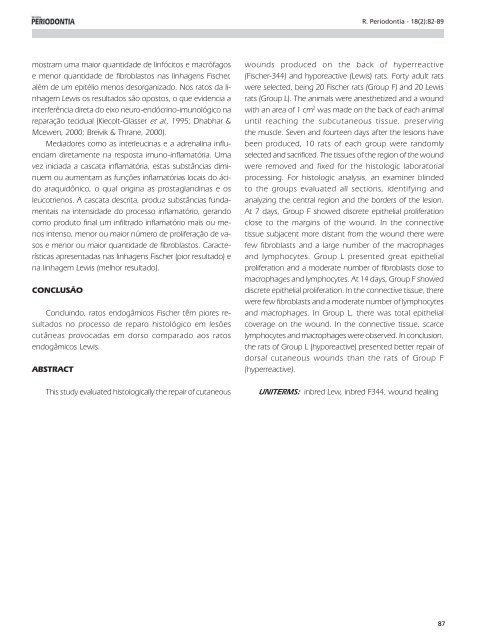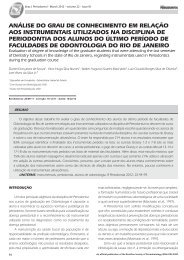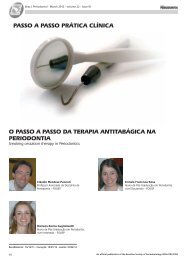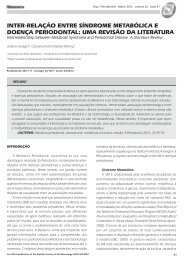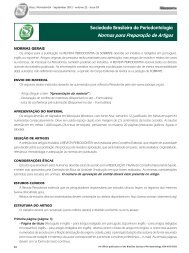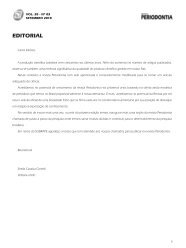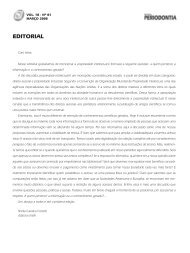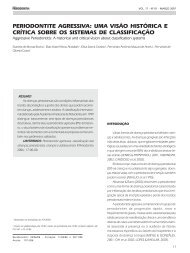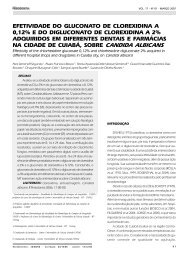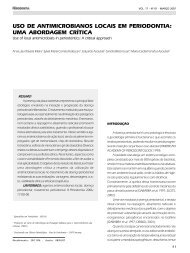Ãndice - Revista Sobrape
Ãndice - Revista Sobrape
Ãndice - Revista Sobrape
You also want an ePaper? Increase the reach of your titles
YUMPU automatically turns print PDFs into web optimized ePapers that Google loves.
R. Periodontia - 18(2):82-89<br />
mostram uma maior quantidade de linfócitos e macrófagos<br />
e menor quantidade de fibroblastos nas linhagens Fischer,<br />
além de um epitélio menos desorganizado. Nos ratos da linhagem<br />
Lewis os resultados são opostos, o que evidencia a<br />
interferência direta do eixo neuro-endócrino-imunológico na<br />
reparação tecidual (Kiecolt-Glasser et al., 1995; Dhabhar &<br />
Mcewen, 2000; Breivik & Thrane, 2000).<br />
Mediadores como as interleucinas e a adrenalina influenciam<br />
diretamente na resposta imuno-inflamatória. Uma<br />
vez iniciada a cascata inflamatória, estas substâncias diminuem<br />
ou aumentam as funções inflamatórias locais do ácido<br />
araquidônico, o qual origina as prostaglandinas e os<br />
leucotrienos. A cascata descrita, produz substâncias fundamentais<br />
na intensidade do processo inflamatório, gerando<br />
como produto final um infiltrado inflamatório mais ou menos<br />
intenso, menor ou maior número de proliferação de vasos<br />
e menor ou maior quantidade de fibroblastos. Características<br />
apresentadas nas linhagens Fischer (pior resultado) e<br />
na linhagem Lewis (melhor resultado).<br />
CONCLUSÃO<br />
Concluindo, ratos endogâmicos Fischer têm piores resultados<br />
no processo de reparo histológico em lesões<br />
cutâneas provocadas em dorso comparado aos ratos<br />
endogâmicos Lewis.<br />
ABSTRACT<br />
This study evaluated histologically the repair of cutaneous<br />
wounds produced on the back of hyperreactive<br />
(Fischer-344) and hyporeactive (Lewis) rats. Forty adult rats<br />
were selected, being 20 Fischer rats (Group F) and 20 Lewis<br />
rats (Group L). The animals were anesthetized and a wound<br />
with an area of 1 cm 2 was made on the back of each animal<br />
until reaching the subcutaneous tissue, preserving<br />
the muscle. Seven and fourteen days after the lesions have<br />
been produced, 10 rats of each group were randomly<br />
selected and sacrificed. The tissues of the region of the wound<br />
were removed and fixed for the histologic laboratorial<br />
processing. For histologic analysis, an examiner blinded<br />
to the groups evaluated all sections, identifying and<br />
analyzing the central region and the borders of the lesion.<br />
At 7 days, Group F showed discrete epithelial proliferation<br />
close to the margins of the wound. In the connective<br />
tissue subjacent more distant from the wound there were<br />
few fibroblasts and a large number of the macrophages<br />
and lymphocytes. Group L presented great epithelial<br />
proliferation and a moderate number of fibroblasts close to<br />
macrophages and lymphocytes. At 14 days, Group F showed<br />
discrete epithelial proliferation. In the connective tissue, there<br />
were few fibroblasts and a moderate number of lymphocytes<br />
and macrophages. In Group L, there was total epithelial<br />
coverage on the wound. In the connective tissue, scarce<br />
lymphocytes and macrophages were observed. In conclusion,<br />
the rats of Group L (hyporeactive) presented better repair of<br />
dorsal cutaneous wounds than the rats of Group F<br />
(hyperreactive).<br />
UNITERMS: inbred Lew, inbred F344, wound healing<br />
87


